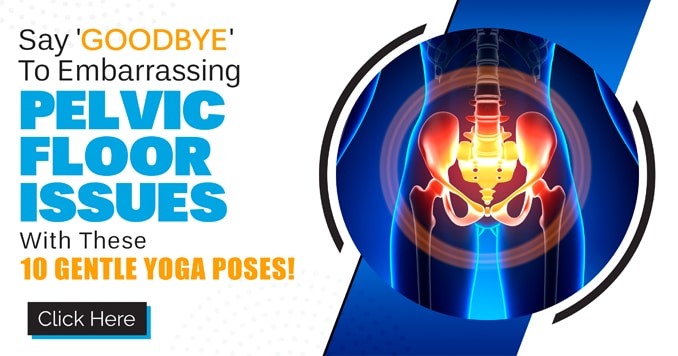
A groin strain injury is a pain to deal with, whether you’re an athlete or just an average person dealing with everyday pains. It is something that’s encountered without proper exercise and excessive activities. In this article, let us dive into the 5 Groin Strain Exercises for Effective Relief.
A groin injury can be limiting, but with the right tips and the perfect exercise plan, you can accelerate your recovery for strength and mobility. Keep reading as we empower you to overcome your groin strain injuries, return to an active, pain-free life, and give you that sweet relief you’re looking for.
What is Groin Strain?
A groin strain occurs when a groin muscle is torn due to excessive activity. Groin muscles are located on the parts where the abdomen meets the legs. Similar to a ‘sports hernia‘, these slight tears on your adductor muscles result in the injured side bulging in the affected area.
Groin injuries can happen during physical activities like soccer or basketball. It also occurs when pushing, pulling, or even when falling. The injury varies from a minor strain to a significant muscle tear that requires physical therapy. This is why groin strain exercises are important, it’s to prevent problems and reduce the chances of having them in the future.
Types of Groin Strains
Groin strains are classified into three distinct categories, each representing varying degrees of severity and challenges that escalate as the injury worsens:
A. Minor Strain
Individuals with minor groin strain typically feel discomfort or pain in the groin region. They may experience a limited range of motion and find it slightly challenging to bear weight on the injured side of the affected leg.
B. Moderate Strain
Those with moderate a groin strain face similar challenges as those with minor groin strains. Symptoms such as muscle spasms, stiffness in the thigh muscle, and slight muscle tearing are commonly associated with moderate strains.
C. Major Strain
Lastly, those who experience a major groin strain, in addition to the challenges with minor and moderate groin strains, also experience significant tears in the muscles on their injured side, inability to walk, and intense pain by keeping their thigh muscle tight even at rest are one of the many problems for a major groin strain.
The Importance Of Exercising Our Groin Muscles
Our groin muscles are important as the muscles in the groin area, specifically the hip adductor muscle group, are important in stabilizing the hip joint. This ensures smooth movement of the legs.
A strong groin muscle group contributes to overall lower body strength and stability. Enhancing these muscles in the inner thigh prevents imbalances that lead to issues in the legs’ adductor muscles and thigh muscles.
Regular exercise helps maintain the strength and flexibility of the thigh muscles, reducing the risk of injuries such as adductor strain, pulled groin, and muscle weakness outside and inside the thigh. Targeted exercises can improve the range of motion, reducing the likelihood of muscle tightness and adductor strains.
Overall, exercises aid in rehabilitation by promoting healing and preventing re-injury for those recovering from groin injuries. However, it should only be done after the swelling in the groin muscles decreases.
Tip When Exercising
A groin strain is a problem for everyone who does physical activities, as it hinders them and limits their movement, specifically their injured side.

Here are some tips to help you exercise:
Stretch Gently
In doing these Groin Strain Exercises, you must begin stretching slowly to prevent issues such as overstretching and further muscle tears.
Gradual Progression
Always start with low-impact exercises, then gradually increase intensity as you heal. Avoid advanced movement and exercises such as a straight leg raise, standing groin stretch, hip flexion, and hip extension.
Rest And Recovery
During the acute phase of a groin strain, it is crucial to prioritize rest over consistently exercising to prevent further injury and promote early healing.
Always Have Support
When exercising, always have someone nearby for support or use equipment that eases the pain as you exercise, such as pillows, chairs, and mini-bands.
5 Groin Strain Exercises For Effective Relief
1. Spinal Twist
Lie on your back on the floor, maintaining good alignment with your head, shoulders, hips, and legs. Place both hands at your sides. Then, bend one knee with your foot flat on the floor. Engage your core, then twist through your lower back, pelvis, and spine, bringing your bent knee halfway across your body. Afterward, hold this position for 20 seconds. Finally, return to the starting position and repeat the movement on the opposite side. Start off with 1 set of 2 repetitions on each side.
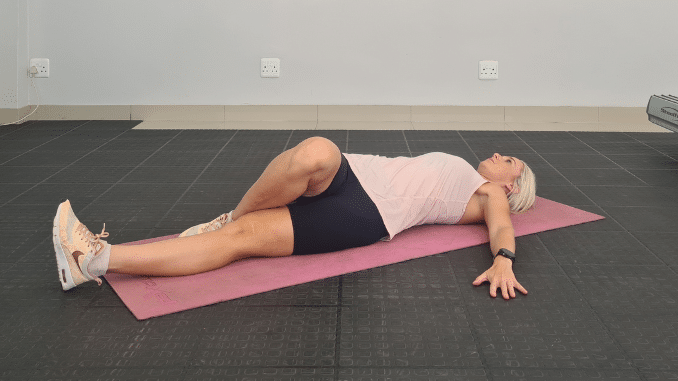
Spinal Twist
Note: Slowly lower your leg only to the point where it doesn’t cause any pain.
2. Supine Butterfly Pose
Lie on your back on the floor, with your knees bent and your feet flat on the floor, maintaining a good alignment with your head, shoulders, and hips. Then, place your hands by your ears or interlace your fingers behind your head. Engage your core, then bring the soles of your feet together. Open your knees out to the sides and relax your body. Lastly, hold this position for several deep breaths, in through your nose and out through your mouth. Perform the movement for 6 repetitions.
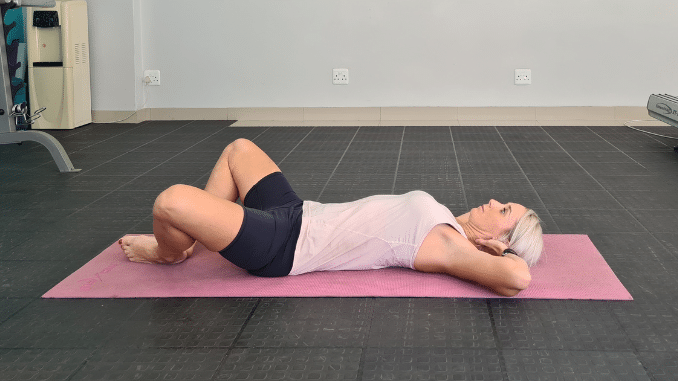
Supine Butterfly Pose
3. Single Leg Lifts
Lie on your side with your injured leg on top of the uninjured leg. Then, rest the side of your head on your arm, keeping your shoulders, hips, and legs aligned. Engage your core and lift your leg carefully. Then, slowly lower it back down, returning to the starting position. Lastly, complete the movement for 5 repetitions.
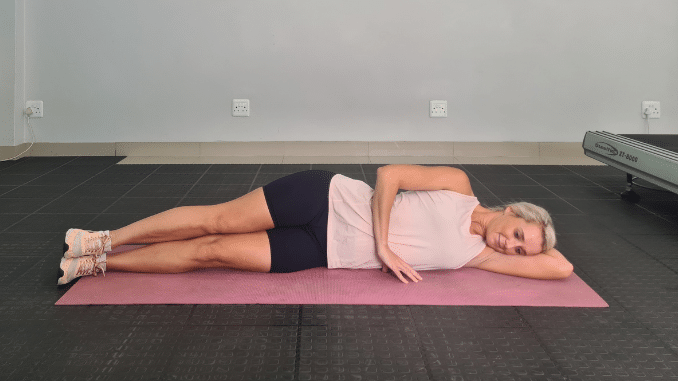 |
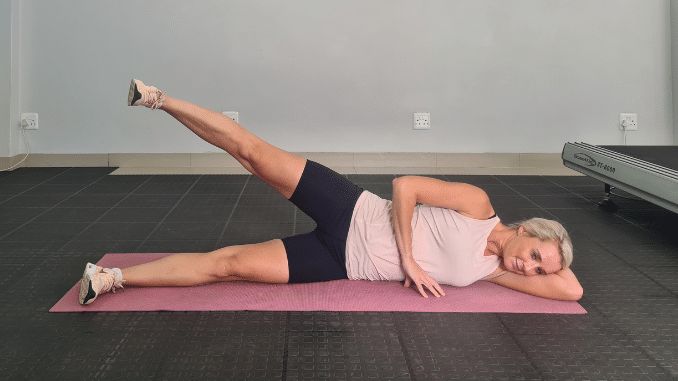 |
Seated Butterfly Stretch
4. Resisted Hip Abduction
For this exercise, utilize an exercise mini-band for added resistance if needed.
- Loop one end of the exercise band around the chair, cable, or table’s leg.
- Loop the other end of the band around your injured leg.
- Hold onto something stable for balance if needed.
Begin in an upright standing position with your legs straight and feet hip-width apart, maintaining good alignment with your head, shoulders, hips, and legs. Shift all of your weight onto your one foot, then gently extend your injured leg out to the side, creating resistance on the band. Then, focus on feeling the stretch in your hamstrings with each pull. Gradually return to the starting position. Lastly, complete this movement for 1 set of 5 repetitions.
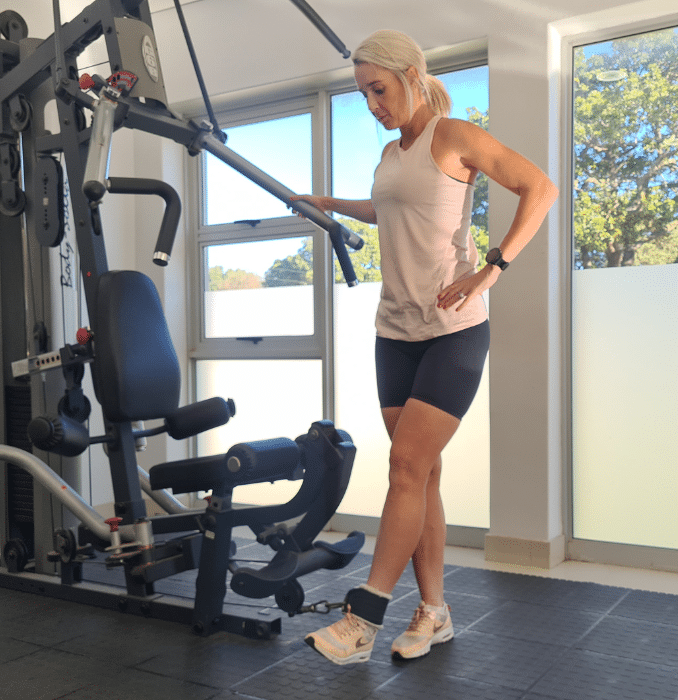 | 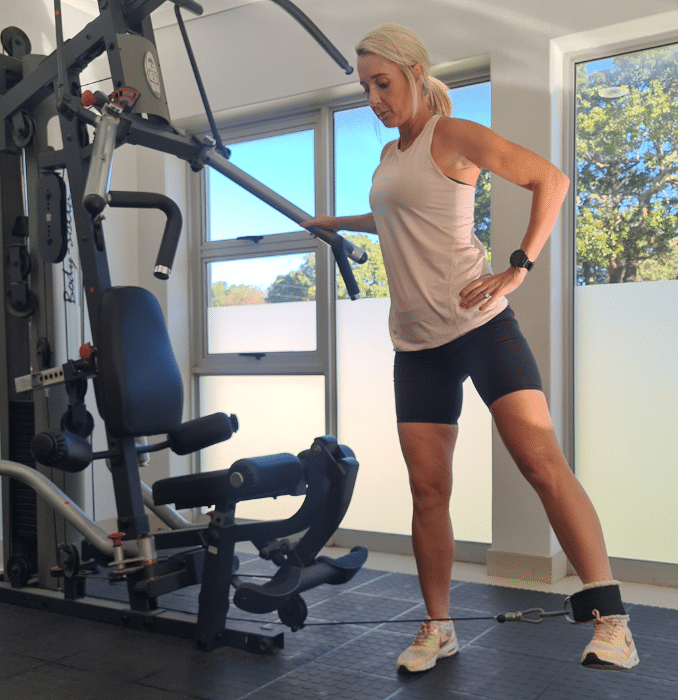 |
Resisted Hip Abduction
5. Seated Butterfly Stretch
Begin in an upright sitting position on the floor, maintaining good alignment with your head, shoulders, and hips. Engage your core and bring the soles of your feet together, opening your knees out to the sides while keeping your spine straight. Hold this position for several deep breaths, through your nose and out through your mouth. Complete this movement for a set of 5 repetitions.
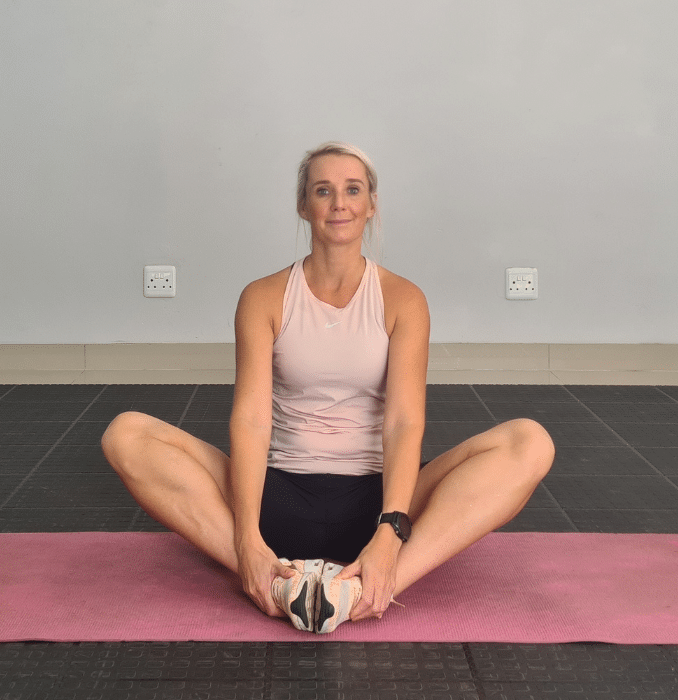
Seated Butterfly Stretch
Movements To Avoid
Understanding what movements to avoid during your recovery from a groin strain is essential to ensure your groin muscles undergo a smooth healing process and prevent further damaging the injured side.
By avoiding the following activities, you can protect yourself from unnecessary groin pain:
- Sudden Twisting Movements
- Walking on Uneven Surfaces
- Sudden Changes in Direction
- Lifting Heavy Objects
- High-Impact Exercises
Conclusion
Groin health is crucial for mobility, injury prevention, core stability, pelvic floor support, reproductive health, comfort, improved posture, and overall well-being, emphasizing the importance of regular exercise and a healthy lifestyle. We hope this guide has provided you with valuable insights and awareness. If your groin pain persists, seek proper advice from your physical therapist. Remember, patience is the key to letting your body heal, and soon you’ll be back to being your active self.
It’s time to take back your life and stop avoiding activities and situations that you fear will compromise your bladder. In just minutes each day, you can easily strengthen your pelvic floor muscles, allowing you to finally live the life you want. Introducing our 10 Gentle Yoga Poses for a Strong Pelvic Floor you should check out now!

